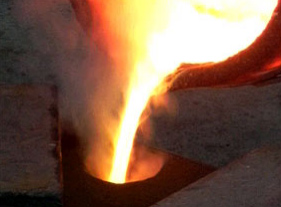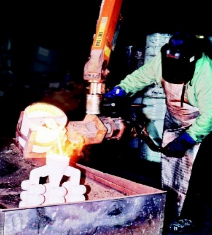Hazards and Control Measures of Molten Metal

Molten metal is a serious hazard in melting pouring applications of metal casting. Workers who execute tasks with or near the molten metal are highly prone to risks, such as coming in contact with metal splashes or be exposed to electromagnetic radiation.
Some of the circumstances that may increase the risk of hot metal splashes are -
- Charging a furnace with impure or moist scrap metal and alloys
- Using damp tools, molds or other material when touching the molten metal
- Pouring or tipping the molten metal into a holding furnace or ladle
- Slagging or skimming processes
- Pouring the molten metal from ladles into molds
Extreme caution should be taken to ensure that the metal or metal slag does not come in contact with water, as it may result in an explosive reaction or ejection of molten metal with catastrophic effects.
Molten metal also emits electromagnetic radiation in the furnace and pouring areas. Foundry workers are primarily endangered to infrared and UV radiation.
Workers and other visiting people with medical implants, plates, joints or similar objects should move into the induction furnace region with care as the magnetic fields of the melting process may cause a charge in the metallic implant. People with cardiac pace makers are especially at risk and should be restrained from entering the induction furnace or touching the equipment.
Health consequences of molten metal
Splashes of the molten metal and the radiant heat during the melting and pouring process may result in serious burns on the body. Sparks from molten metal may also affect the eyes. Vulnerability to infrared and ultraviolet rays may result in the damage of eyes including cataract.
Control measures
There are several measures and options, which can be adopted alone, or in combination, to prevent or minimize the risks associated with the handling of molten metal in foundries.
Mechanical control measures
The risks associated with the molten metal can be reduced or minimized by implementing mechanical controls. Barriers and other protecting covering, including the mobile shields should be used or set up to protect workers against the splashes of molten metal and electromagnetic radiation.
Administrative control measures
Administrative controls include the development and inclusion of safe working practices and procedures.
Some of common examples of administrative control measures for molten metals include -
- Keep all the combustible materials and volatile liquids at a safe distant place from the melting and pouring areas.
- Make sure that the molten metal does not come in contact with water or other contaminants. All charge materials, ladles and other equipment, which may come in contact with the molten metal should be totally dry.
- Restrain the unauthorized access by barriers and signages to the furnace and pouring areas.
- Restrain the workers and other personnel from wearing synthetic clothing, including undergarments while entering the furnace and pouring regions.
- Ensure proper use and maintenance of personal protective equipment.
Personal protective equipment
Personal protective equipment are a must to reduce or eliminate the risks associated with the handling of molten metal in foundries. These may include -
- Heat resistant protective clothing - headgear, footwear, face shields, aprons, fire retardant spats, coats and gaiters
- Eye protection with side shields



